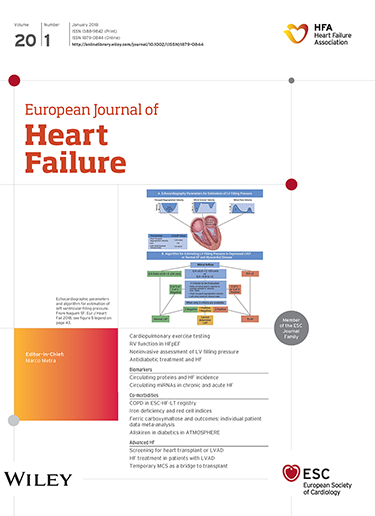锻炼左房顺应性:保留射血分数辅助心力衰竭工具箱中的又一工具?
IF 16.9
1区 医学
Q1 CARDIAC & CARDIOVASCULAR SYSTEMS
引用次数: 0
摘要
本文章由计算机程序翻译,如有差异,请以英文原文为准。
Exercise left atrial compliance: One more tool in the heart failure with preserved ejection fraction assistance toolbox?
This article refers to ‘Diagnostic value of reduced left atrial compliance during ergometry exercise in heart failure with preserved ejection fraction’ by T. Harada et al. , published in this issue on pages 1 293– 1 303. Heart failure with preserved ejection fraction (HFpEF) accounts for approximately half of all heart failure cases; however, the exact clinical diagnosis of HFpEF remains challenging. According to the 202 1 European Society of Cardiology guidelines, exercise invasive haemodynamic cardiac catheterization remains the gold standard to unequivocally confirm the diagnosis of HFpEF for those with inconclusive results from diagnostic criteria. 1 Typical haemodynamic presentations in HFpEF patients may include elevations in left ventricular end-diastolic pressure (LVEDP), pulmonary capillary wedge pressure (PCWP), and pulmonary artery pressure, which occur in parallel to each other. Provoked haemodynamics during exercise is crucial for patients with HFpEF, as some patients with HFpEF may show normal PCWP at rest under scenarios of decon-gestive or euvolaemic status (masked) and manifest a steep rise of PCWP during exercise from increased venous return into a more stiff left ventricle. 2 In this case, abnormal haemodynamic responses during exercise, yet maintained within normal range at rest, reflects impaired diastolic functional reserve in HFpEF, and may lead to limited exercise capacity presenting with exertional dyspnoea and effort intolerance ( Figure 1 A ). 3 This emphasizes the role of
求助全文
通过发布文献求助,成功后即可免费获取论文全文。
去求助
来源期刊

European Journal of Heart Failure
医学-心血管系统
CiteScore
27.30
自引率
11.50%
发文量
365
审稿时长
1 months
期刊介绍:
European Journal of Heart Failure is an international journal dedicated to advancing knowledge in the field of heart failure management. The journal publishes reviews and editorials aimed at improving understanding, prevention, investigation, and treatment of heart failure. It covers various disciplines such as molecular and cellular biology, pathology, physiology, electrophysiology, pharmacology, clinical sciences, social sciences, and population sciences. The journal welcomes submissions of manuscripts on basic, clinical, and population sciences, as well as original contributions on nursing, care of the elderly, primary care, health economics, and other related specialist fields. It is published monthly and has a readership that includes cardiologists, emergency room physicians, intensivists, internists, general physicians, cardiac nurses, diabetologists, epidemiologists, basic scientists focusing on cardiovascular research, and those working in rehabilitation. The journal is abstracted and indexed in various databases such as Academic Search, Embase, MEDLINE/PubMed, and Science Citation Index.
 求助内容:
求助内容: 应助结果提醒方式:
应助结果提醒方式:


